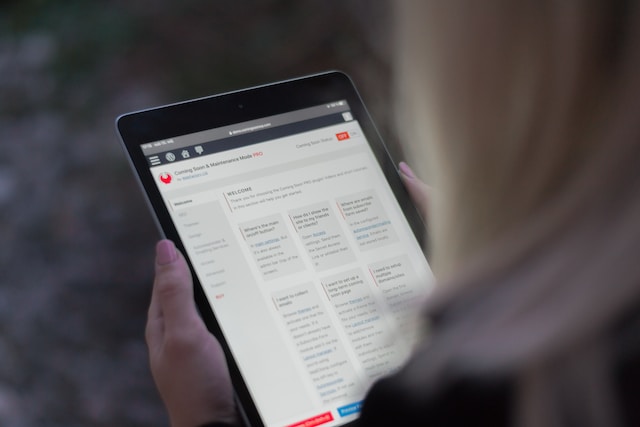Education has undergone a significant transformation in recent years. In 2023, over 70% of US students said they would like to continue with eLearning, even after the pandemic, and 90% of companies offer eLearning to their employees.
Some of the main benefits of eLearning are the flexibility and accessibility it offers to learners of all ages. Students and employees can access educational content from anywhere, anytime, and for an affordable price. The biggest requirement for successful eLearning is a reliable internet connection. Unlike traditional classrooms, eLearning provides flexibility and a personalized approach to education.
Table of Contents
- The basis of eLearning
- Setting up your eLearning space
- Developing effective study habits
- Tech set-up for your eLearning space
The basis of eLearning
eLearning, or online education, offers many advantages over traditional classroom learning. Whether you’re a student, a working professional, or someone looking to acquire new skills, eLearning provides different options for learning and growing.
Advantages of online learning
- Flexible learning: eLearning allows you to learn at your own pace and schedule. You can study whenever and wherever convenient, without the need to stick to fixed class schedules. With online courses, you can access lectures, materials, and assignments at any time, allowing you to learn at your own pace
- Access to resources: Online libraries, databases, and digital materials can enhance your learning experience by offering readily available information. eLearning platforms often incorporate interactive learning materials, videos, and simulations that engage and enhance understanding
- Eliminating geographical barriers: You can connect with educators and students worldwide, expanding your network and gaining diverse perspectives. Additionally, eLearning allows you to access courses and programs offered by universities and institutions located in different cities or countries, giving you the opportunity to learn from various experts and institutions without the need to invest in transportation or enroll in universities with high fees. For example, many online coding classes and beginner courses gained popularity across the world in helping students learn coding skills for whatever piques their interest.
Disadvantages of online learning
While eLearning has many benefits, it’s essential to acknowledge the challenges that come with this digital shift.
- Distractions: One of the primary concerns of students and educators is distraction, which can affect the learning process. Without the structured environment of a traditional classroom, learners may find themselves dealing with interruptions from household activities, social media, or other external distractions
- Lack of face-to-face interaction: Learners may miss the immediate feedback, collaborative discussions, and social connections gained in physical classrooms
- Technical issues: Technical challenges, such as poor internet connectivity or software glitches, can interfere with the productivity of eLearning. These issues can lead to frustration and disrupt the learning experience
How to access eLearning content
As technology grows, eLearning tools will evolve further, providing greater accessibility and customization for learners worldwide through different platforms.
- Learning Management Systems (LMS) are now essential tools for online education. They provide a centralized hub for course materials, assessments, and communication. Universities have increasingly incorporated these systems into their academic frameworks. LMS platforms facilitate smooth interaction between students and instructors, fostering a collaborative virtual environment where resources are easily accessible and progress can be tracked.
- Students can access eLearning content through portals provided by their university play an important role in shaping access to eLearning content, leveraging in-house technology to enhance traditional teaching methods. Universities deliver lectures, assignments, and assessments through dedicated online portals, enabling students to engage with course material at their own pace.
- There are plenty of eLearning platforms to choose from nowadays. Independent learners have embraced the freedom and autonomy afforded by eLearning platforms, such as Udemy, Codecademy, and LinkedIn Learning. Several industry experts also run their own online courses through platforms like GetResponse. People seeking to upskill or pursue personal interests can access these platforms for online courses, webinars, and resources tailored to their specific needs.
Setting up your eLearning space
Creating a dedicated study space ensures a productive and focused eLearning environment. By setting up a designated area for your online classes and study sessions, you can minimize distractions and optimize your learning experience.
Tips for creating an effective study environment
Here are some suggestions for creating a practical study space:
- Choose a quiet and comfortable area. Find a space in your home where you can concentrate without interruptions. Consider using noise-cancelling headphones or earplugs if necessary
- Set up your computer and practice equipment safety. Make sure your computer or laptop is in good working condition. This will prevent technical issues that could disrupt your learning. Keep cables organized to avoid tripping hazards and invest in surge protectors to safeguard electronic devices from power fluctuations. Regularly check the condition of your equipment, such as laptops and chargers, to address any potential safety concerns
- Have all the necessary materials within reach; keep your textbooks, notebooks, pens, and other study materials nearby so that you can quickly access them when needed
- Organize your study space by decluttering unnecessary items and employing storage solutions to keep materials neatly arranged
- Make your study space inviting and conducive to learning by adding personal touches. Consider decorating it with motivational quotes, artwork, or plants
- Consider placing indoor plants to improve air quality and introduce a touch of nature. Additionally, position your study area near windows to capitalize on natural light and ensure proper air circulation. Exposure to natural light has been linked to increased productivity and mood. Open windows from time to time to refresh the air
- Invest in ergonomic furniture for comfort and to reduce the risk of discomfort or injury during prolonged study sessions. Ensure your chair provides proper lumbar support, and your desk is at an appropriate height to prevent strain
Developing effective study habits

Having study habits can create a structured and effective learning routine to improve your online learning experience. Finding a healthy work-life balance is an ongoing process; here are some strategies to help you maximize your learning and stay on track:
- Create a schedule: First, start by setting aside time for studying and completing assignments. A study plan will help you stay organized and ensure that you prioritize your online learning activities
- Develop time management skills: Effective time management is crucial for online study. Consider using techniques like the Pomodoro Technique, where you break your study time into focused intervals followed by short breaks. This can help increase productivity and prevent burnout
- Stay organized: Keep track of deadlines, assignments, and important information by using digital tools and planners. By staying organized, you can avoid last-minute stress
- Set goals: Set clear and realistic goals for your online learning journey. Whether completing a certain number of modules or achieving a specific grade, having goals will keep you motivated and focused
- Establish boundaries: Set clear boundaries between your online learning and personal life. Share your study schedule with family members or roommates so they understand your need for uninterrupted study time. Establishing these boundaries will help you maintain a healthy work-life balance and optimize your learning experience
- Practice self-care and well-being: Taking care of your physical and mental well-being is crucial for your overall success in online learning. Regular exercise or engage in other physical activity to reduce stress and increase energy levels. Use relaxation techniques like breathing exercises or meditation to increase focus and remain calm. Take breaks to engage in activities you enjoy, whether reading a book, listening to music, or spending time with loved ones. Self-care helps to maintain a positive mindset and avoid burnout
Engaging in virtual classrooms
Active participation in virtual classrooms is essential for meaningful learning and is one of the most effective study habits for success. Therefore, engage in online discussions, ask questions, and contribute to group projects. Taking an active role in your virtual classroom enhances your understanding of the material and allows you to connect with your classmates and build a sense of community.
Online discussions
Online discussions provide a platform for exchanging ideas and perspectives with your peers. It helps to improve your understanding of the subject and gain valuable insights from your classmates. Take the opportunity to share your thoughts, ask thought-provoking questions, and respond to others’ contributions. Remember to be respectful and constructive in your interactions.
Virtual collaboration
Group projects and virtual collaborations are a common part of eLearning. It can enhance problem-solving skills, gain new perspectives, and develop teamwork abilities. Take advantage of the virtual collaboration features available in your online learning platform, such as chat rooms and breakout rooms, to collaborate effectively.
Student engagement
To fully engage in your virtual classroom, actively participate in class activities and assignments. Interact with your instructor, ask questions, and seek clarification when needed. Take advantage of interactive features like polls or quizzes to test your understanding of the material.
Tech set-up for your eLearning space

The tech side of setting up your space is crucial to your overall learning experience. You must invest in the right equipment and set up a reliable home Internet connection for effective video conferencing, quick access to study materials, and online collaboration.
Setting up the right equipment means ensuring clear audio and video and minimizing disruptions during virtual classes. Invest in a quality webcam, microphone, and headphones to enhance your communication and engagement in the digital classroom. Equip yourself with tools for better interaction, such as messaging apps, collaborative document editing platforms, and virtual whiteboards. Utilize cloud storage solutions to access documents and resources from any device easily.
Setting up a reliable home internet connection
Furthermore, invest in a high-speed internet connection is fundamental for optimal performance in eLearning. A reliable and fast connection minimizes buffering during videos and smooth access to materials such as quizzes and ebooks. Consider consulting specialists or technicians to ensure optimal configuration when setting up a home internet connection. Their expertise can help address potential issues and optimize your network for a smoother eLearning experience.
How to choose the right internet plan
Consider a few factors when setting up your internet connection and selecting the right plan.
- Bandwidth requirements: Evaluate the bandwidth requirements of your eLearning activities. High-quality video software and downloading large study materials demand sufficient bandwidth. Choose a plan that aligns with your usage patterns to prevent slowdowns
- Upload speed: While download speed is important, pay attention to the upload speed. A balanced upload speed is essential for activities like participating in video conferences, uploading assignments, and collaborating on shared documents
- Data limits and their impact on uninterrupted access: Be mindful of data limits imposed by internet plans. Exceeding data limits can lead to interruptions in your online activities. Opt for plans with sufficient data allowances or unlimited options to ensure uninterrupted access throughout your eLearning sessions
- Reliability: Assess the reliability of the internet service provider in your area. Check for reviews and feedback from existing customers as a reference
- Availability of fiber optic or broadband: Check if fiber optic or broadband internet is available in your area. These technologies typically offer faster and more reliable connections compared to traditional DSL connections
- Throttling policies: Inquire about any throttling policies that the provider may have. Some providers may slow down the internet speed during peak hours, impacting your online activities
- Educational discounts or plans: Some Internet service providers offer special plans or discounts for students. Inquire about any educational promotions that might provide cost savings
- Customer support: Evaluate the customer support services the Internet service provider provides. Reliable and responsive customer support is essential in resolving issues promptly
- Ensure compatibility with educational needs: Finally, consider the specific requirements of your eLearning platform and educational tools. Ensure that your internet plan is compatible with the technology used in your courses, preventing compatibility issues and optimizing your online learning experience
If you’re unsure about the right Internet plan, don’t hesitate to seek guidance from Internet service providers to understand the features of different plans. Discuss your needs with providers to receive recommendations tailored to your requirements.
Tech support advice for connectivity issues
Technical issues can sometimes occur while online learning, but you can quickly get back on track with a few troubleshooting tips. Here are some strategies to help you overcome common technical challenges:
- Check your Internet connectivity: Ensure you have a stable Internet connection before starting online classes. Connect your device to a reliable Wi-Fi network, or try using an Ethernet cable for a more stable connection. If you encounter connectivity issues, try restarting your router. Contact your internet service provider for assistance when needed
- Familiarize yourself with the online learning platform: Take the time to explore the features and functions of your eLearning platform. This will help you navigate through the virtual classroom and troubleshoot any technical issues. If you need help using a specific feature, contact your instructor or consult the platform’s user guide for guidance
- Have a backup plan: It’s always a good idea to have a backup plan in case of internet outages or hardware malfunctions. Consider having a mobile hotspot or a backup device available for emergencies. Additionally, save your work frequently in case of unexpected technical issues

eLearning offers unique opportunities for learning and personal growth. By following the strategies and tips outlined in this online learning guide, you will be well-equipped to get started with online learning. Make sure you have the right equipment, excellent Internet connection, and the skills needed to be a successful online learner.




